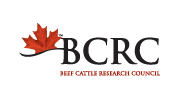Determining the minimum fibre requirement for feedlot cattle
| Project Code: | FDE.01.17 |
| Completed: | In Progress. Results expected in March 2023. |
Project Title:
Determining the minimum fibre requirement for feedlot cattle and improving the empirical prediction of ruminal pH
Researchers:
Greg Penner Ph.D. and Katie Wood Ph.D. greg.penner@usask.ca
Greg Penner Ph.D. (University of Saskatchewan); Katie Wood Ph.D. (University of Guelph); John McKinnon Ph.D. (University of Saskatchewan); Wenzhu Yang Ph.D., Tim McAllister Ph.D., Karen Beauchemin Ph.D., Karen Schwartzkopf-Genswein Ph.D., Yuxi Wang Ph.D. (Agriculture Agri-Food Canada Lethbridge); Joyce van Donkersgoed D.V.M. (Alberta Beef Health Solutions); Darryl Gibb Ph.D. (Gowans Feed Consulting)
Background:
High grain diets improve feed conversion efficiency but contribute to abnormal behavior (eating bedding and fences), acidosis and liver abscesses, which are offset with antibiotics. A better understanding of fibre requirements may help find ways to maintain efficiencies while reducing the health, welfare and antibiotic use concerns. Research has not defined whether these issues are related to absolute fibre levels, forage:concentrate ratio, or specific fibre fraction(s). Fibre requirements may also vary with digestibility, fibre particle size, starch source, processing, etc.
Objectives:
To evaluate criteria that may affect the fibre requirement for feedlot cattle, and improve the ability to predict ruminal pH in feedlot cattle using dietary parameters.
What They Will Do:
Phase 1: Effect of undigestible NDF (uNDF) on dietary fibre requirements
Study 1: Six cannulated heifers will be fed low (5%), medium (10%) or high (15%) roughage rations containing either barley silage (5.9, 6.2 or 6.5% uNDF) or straw. Each diet will be fed for 24 days, and animals will be rotated among all six diets. Intake, rumen pH, rumen motility, chewing, particle size and sorting will be measured, along with rumen SCFA and blood glucose and insulin.
Study 2: Similar to Study 1, except heifers will be fed barley silage (long chop length, short length, short chop length plus straw) or wheat silage (long chop length, short length, short chop length plus straw).
Study 3: 360 steers will be fed one of four finishing diets for 126 days. Based on the studies above, diets will contain uNDF levels ranging from inadequate to excessive using different chop lengths or levels of barley straw. Performance and variability within a pen, behavior, lameness, locomotion, carcass weight, shrink, yield and quality grades, and liver scores will be measured.
Phase 2: Effect of starch fermentability on dietary fibre requirements
Study 4 (AAFC): Similar to Study 1, except heifers will be fed barley grain with a low (65%), medium (75%) or high (85%) processing index and either low or high uNDF.
Study 5 (AAFC): Similar to Study 1, except some barley grain will be replaced with 0, 10 or 20% DDGS, and straw or forage inclusion rates will be varied to achieve low or adequate uNDF.
Study 6 (UofS): 360 steers will be fed finishing diets containing moderately or highly fermentable carbohydrate diets, with low or adequate uNDF. Performance and variability within a pen, behavior, lameness, locomotion, carcass weight, shrink, yield and quality grades, and liver scores will be evaluated.
Phase 3: Integration of the Model
2x2 factorial treatment arrangement comparing moderately (corn) and highly (barley) fermentable carbohydrate source, with adequate or low uNDF. Feed intake, feeding behavior, rumen pH and animal performance will be measured.
Phase 4: Predict rumen pH based on diet variables
Data from these and other published studies will be used to develop and validate a model to improve the empirical prediction of ruminal pH in beef cattle finishing diets.
Implications:
This project will identify fibre fraction(s) and levels that promote and maintain optimal rumen and animal health while facilitating efficient digestion and feed conversion. This will help to reduce in-feed antimicrobial use while ensuring animal welfare and productivity.








